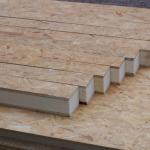Braid dreadlocks - how to make dreadlocks at home
There are many different methods for doing this, but it depends on whether you are a lazy person or not, everyone chooses a method for themselves. Here are some of them:
Combing
So, what are the benefits: the hair looks like dreadlocks from the moment of braiding and gets off faster. You can give the dreadlocks the desired size and shape. Combing can be done on hair from 8 cm or more.
And now about the bad: the initial process takes several days and is quite laborious (for the patient ones), the same patient friends will help here (there is nowhere to go without them). Take your time and try to immediately make the dreadlocks smooth and dense (then it will be very difficult to correct the flaws).
You need: Comb (comb). Wax for dreadlocks (it was described in the CARE section) or a crochet hook. Rubber bands.
So, let's transgress: Divide the hair into identical square sectors. Choose the size yourself, the thickness of the dreadlock depends on the size, the size is 1-2cm. suitable for many people. Elastic bands are put on the strands (little funny ponytails are obtained). Some people do not remove the elastic bands during weaving (this muffles the pain, and after removing the elastic bands, the hair is not very tight). After the hair is parted, use a comb to comb the hair back. This process can also be done by hand. Roll the strand to a downed state, and then proceed to weaving, lowering the stray mass to the roots. Pass the comb repeatedly to the roots. As a result, the hair will begin to stray at the roots. It is not necessary to roll the hair at the very bottom, but it is necessary to tangle the hair that you hold in your hands between your fingers when combing it. Comb to the end of the hair, trying to make the dreadlock as dense as possible. At the end of the dreadlock, you can put on an elastic band to secure the dreadlock (it will not look very nice), so it's better to tuck in a string (or, in extreme cases, a crochet hook). The use of elastic at the roots can be avoided by braiding the dreadlocks from below. The elastic band can be removed after the dreadlock has gone astray. You can apply wax that does not contain petroleum.
The wax will hold loose hair together and help it dread out much faster. Dreadlocks made by backcombing look like dreadlocks right off the bat, but they won't tangle right away and won't smooth out completely. Using a good soap and wax will help your dreadlocks. This will help dreadlocks achieve the desired result in 3-4 months. The hair continues to grow back, but it needs your help. You can wear elastic at the root of your dreadlocks to help them tangle. And here's a little hint for you: it is better to weave dreadlocks from clean, chemical-free hair, this helps the process go much faster. Any residue in the hair helps the hair to slip out of the knots when you comb it. Also make sure your hair is completely dry.
Rubbing wool
So, what are the benefits: You don't need wax or shampoo for dreadlocks. You can start it as soon as you have something woolen in your hands. You can do it yourself without helpers.
And now for the bad: It damages the hair a lot, the dreadlocks are unpredictable in size, and look ugly. And if you don’t like the result, you will have to shave off the hair and grow it again.
You need: Something woolen
So let's get started: Take some woolen item (it can be a sweater, a hat, a scarf, etc.). Start rubbing this on your head in a circular motion, after about 15 minutes, if your hair is long enough it will start to tangle. Then you break the stray strands of hair and try to divide the resulting dreadlocks. After you have torn them apart, rub and rub again for about 15 minutes. Repeat this process many times until all your hair is tangled. With this method, as well as the neglect method, a lot of loose hair is left, you can try to weave it into the near dreadlock.
Self-forming dreadlocks
 What's good: you can do it without any help. This is the easiest way. No special tools or products are needed, only time.
What's good: you can do it without any help. This is the easiest way. No special tools or products are needed, only time.
And of course, about the bad: this process takes at least 3-4 years for the hair to just start to resemble dreadlocks. The length of the hair should be about 25 cm to begin to go astray. The shape of the dreadlocks is uneven, some dreadlocks will be huge or flat, others will be very thin. Everyone usually cannot stand such terrible hair and cut it off. (Would you bear it?)
What you need: Plenty of time. Rubber bands.
And so: The method of neglect is the most wait. You just need to keep your hair clean. Let your hair grow and in about a year they may already begin to stray into strands on their own. But it may take much longer, about 3 years (depending on the length and type of hair). You can tear large tangled strands into separate dreadlocks, and try to combine thin dreadlocks with elastic bands.
permanent dreadlocks
 What's good: these are fast and almost real dreadlocks.
What's good: these are fast and almost real dreadlocks.
What's wrong: it's a chemical process. Dreadlocks braided at the barbershop require professional maintenance. And they are expensive $200-400.
What you need: Money.
And so: Save your money. Do not weave them, it is better to braid ordinary dreadlocks, braid from some master, there are a lot of them right now and they take less salons. And remember, dreadlocks are not a hairstyle, it's your hair, it's like a leg, an arm, in general, dreadlocks become part of your body, and if you are tuned in to them, you will never cut them.
Twisting
What's Good: It's natural. You control the size of the dreadlocks and how they are shaped.
What's Bad: The method only works well on African textured hair.
What you need: Comb. Wax for dreadlocks. Rubber bands.

So, let's transgress: First, divide the hair into square sectors. The size of the squares is up to you. For starters, you can wear elastic bands on the strands. When the whole head is divided, each strand is twisted clockwise, using a comb to bring down and twist the hair at the ends. As each strand twists, the dreadlock wax needs to support the twist. A dense wax that does not contain petroleum strengthens the hair much better. After knocking down dreadlocks, less dense waxes can be used. Rubber bands can be used at the roots and ends to hold the hair in place for the first few weeks. Just do not tighten the elastic too much, it can break the hair.
Twisting and tearing method
What's good: you can wash every day.
What's bad: Dreadlocks take a long time to form, about 4 months.
What you need: Wax. Shampoo for dreadlocks. Rubber bands.
Let's transgress: Wash your hair with shampoo, while washing your hair, rub your hair clockwise. Then dry your hair in the state in which they will be. When the hair is dry, tear the resulting giant tuft into separate strands. Take each strand and twist, gradually adding wax, and then roll it with your palms. Continue this procedure every day until the strands form into dreadlocks.
Dreadlocks with synthetic hair or safe
 What good: from afar it looks beautiful, and most importantly, when you get bored, you can take them off to damage your hair.
What good: from afar it looks beautiful, and most importantly, when you get bored, you can take them off to damage your hair.
What's Wrong: These aren't dreadlocks at all!
What you need: Wax. Shampoo. Rubber bands. Synthetic hair (kanekalon).
So let's get started: Divide your hair into 1 inch squares. Secure the strand with an elastic band. And so the whole head. Remove the elastic from one of the strands. Divide your hair into 3 different sections and add synthetic hair to one of them. Then leave a sufficient amount of synthetic hair - they should be three times longer than the intended dreadlocks. Braid the hair together with the synthetics down and secure with an elastic band at the end. When you've finished braiding, and put the elastic on the end of the dreadlock, wrap more synthetic hair around the dreadlock all the way to the end and tighten with the elastic. Add some wax to the dreadlock to smooth the hair. And so on the whole head.
Weave dreadlocks
What's good: your hair immediately looks like dreadlocks as soon as you braid it.
What's wrong: it's a terribly painful way for your hair to fly around the room with a bang, but it's worth it.

So, let's start: Divide the hair into equal sectors for this, it is convenient to use a knitting needle, and secure it with rubber bands (ordinary office rubber bands). Take one of the separated strands (it's better to start with bangs). Twist it into a tourniquet and with a sharp movement divide the tourniquet into two parts (and then the long-awaited crack of your hair was heard). Divide one of the parts into two more. Then make one braid, and repeat this procedure until you have braided the entire strand and head. The stray hair is either braided into a dreadlock or cut off. The ends of the dreadlocks (the remaining tails) are woven along the entire length of the dreadlock with a string or a hook, better with a string (this is more convenient). How to do this is described in the care section. If desired, you can smear the finished dreadlocks with wax for dreadlocks and fix the ends with wax. Well, that's all, I wish you good luck in weaving and I hope there will be a quick replenishment of the dreadlocks in our ranks.
Weave and be patient with it. Copyright © Lisa
In contact with




